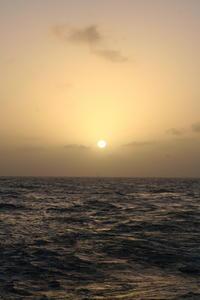Every year 1,700 million tonnes of dust is produced by the deserts in the world. About a third of the dust falls in the ocean.
RRS Discovery UK Nitrogen Fixation - GEOTRACES Expedition 2011
Where and why?
The National Oceanographic Centre, Southampton, the Universities of East Anglia, Plymouth, Liverpool and Cape Town invite you on a virtual journey aboard the UK’s research flagship, the RRS Discovery to experience life on the cutting edge of modern oceanographic and atmospheric science. Between 2 February and 19 March, we’ll be reporting from the RRS Discovery on the challenges and rewards of life at sea.
For the 41 days aboard the RRS Discovery, the scientists and crew will experience a hectic program of ocean and atmosphere sampling – from the free floating phytoplankton and bacteria in the very surface waters of the ocean, to the Saharan dust particles falling in the sea. The cruise is part of the international GEOTRACES programme.
The mission
Our aim is to study the activities and distributions of microbial di-nitrogen (N2)-fixing organisms (diazotrophs) living in the surface waters of the tropical and subtropical Atlantic Ocean, and to quantify the supplies of iron (Fe) and phosphorus (P) to the diazotrophs.
The diazotrophs fix nitrogen (N) from the atmosphere in ocean regions that have extremely low nitrogen (eg nitrate, ammonium) concentrations. It is assumed that their growth is controlled by the availability of Fe and P. Our study region is characterized by high Saharan dust inputs to the surface ocean. The dust supplies significant amounts of Fe, but also some P and N. In addition, at depths between around 150 and 600 m in the region between 16ºN and 0ºN, there is a layer of water in the ocean (oxygen minimum zone) with low oxygen concentrations and high N, P and Fe. Upward mixing of these nutrients may fuel the growth and activity of diazotrophs.
We will be using sophisticated techniques to sample and analyse dust particles in the air above the sea, to sample Fe and other metals/isotopes and nutrients in the water column, measure upward transfer of Fe and other elements to the surface ocean in the oxygen minimum zone. We will also use appropriate techniques to study the effect of the dust on the growth of microscopic plants and bacteria in the sea.
Our cruise track will cover regions frequently affected by dust storms, and also sample the region with low oxygen concentrations in the water column. Winter is a good period for dust storms here. But just like the weather at home, you never know whether dust storms will occur and where!
Why?
Every year 1,700 million tonnes of dust is produced by the deserts in the world. About a third of the dust falls in the ocean. The North Atlantic receives the largest amount of dust because of its proximity to the Saharan desert. We can see the dust storms by satellite. Occasionally we can find this Saharan dust as a yellow-red layer of dust on our cars as far away as in the UK.
When dust particles fall in the ocean, they release a small but important amount of nutrients that are required by the microscopic plants called phytoplankton. In particular, iron, phosphorus but also some nitrogen coming from the dust are required by oceanic phytoplankton.
Concentrations of N and P are extremely low in our study region, and it is thought that the high inputs of Fe from dust and mixed up from the oxygen minimum zone determine the growth and activity of diazotrophs.
Saharan dust storms and, potentially, the oxygen minimum zone therefore deliver crucial amounts of nutrients to the photosynthesising phytoplankton, and in particular supply Fe and P to diazotrophs. The process of nitrogen fixation transfers N2 from the atmosphere to the ocean, where it then becomes available to other phytoplankton whose growth is limited by the availability of N.
The better diazotrophs grow, the more atmospheric N2 they take up and N they supply to other phytoplankton. In turn, these phytoplankton will take up more carbon dioxide (CO2) of which part is sequestered in the deep ocean. This is important to counterbalance the currently increasing anthropogenic CO2 emissions.
We are also very keen to test whether the enhanced Fe concentrations in the low-oxygen waters are derived from the atmospheric dust inputs or come from sediments close to the African mainland. The scientists on this dust cruise are hoping to encounter large dust storms and eventually understand how the dust influences the biology of the ocean, and how the ocean may respond to the climate changes in the near future.
Forget about getting wet and seasick, and take a look at what the crew is up to and check back soon.

